Graphene is a one-atom thick sheet of carbon atoms arranged in a honeycomb lattice. It has remarkable properties such as being very strong yet flexible. The document discusses the history and invention of graphene, its properties such as high conductivity and flexibility, and its advantages over silicon. Potential applications of graphene discussed include use in computer processors, memory, touchscreens, cameras, and for enabling high-speed internet. The future of graphene supercomputing and its potential to replace silicon is also examined, along with some current limitations.
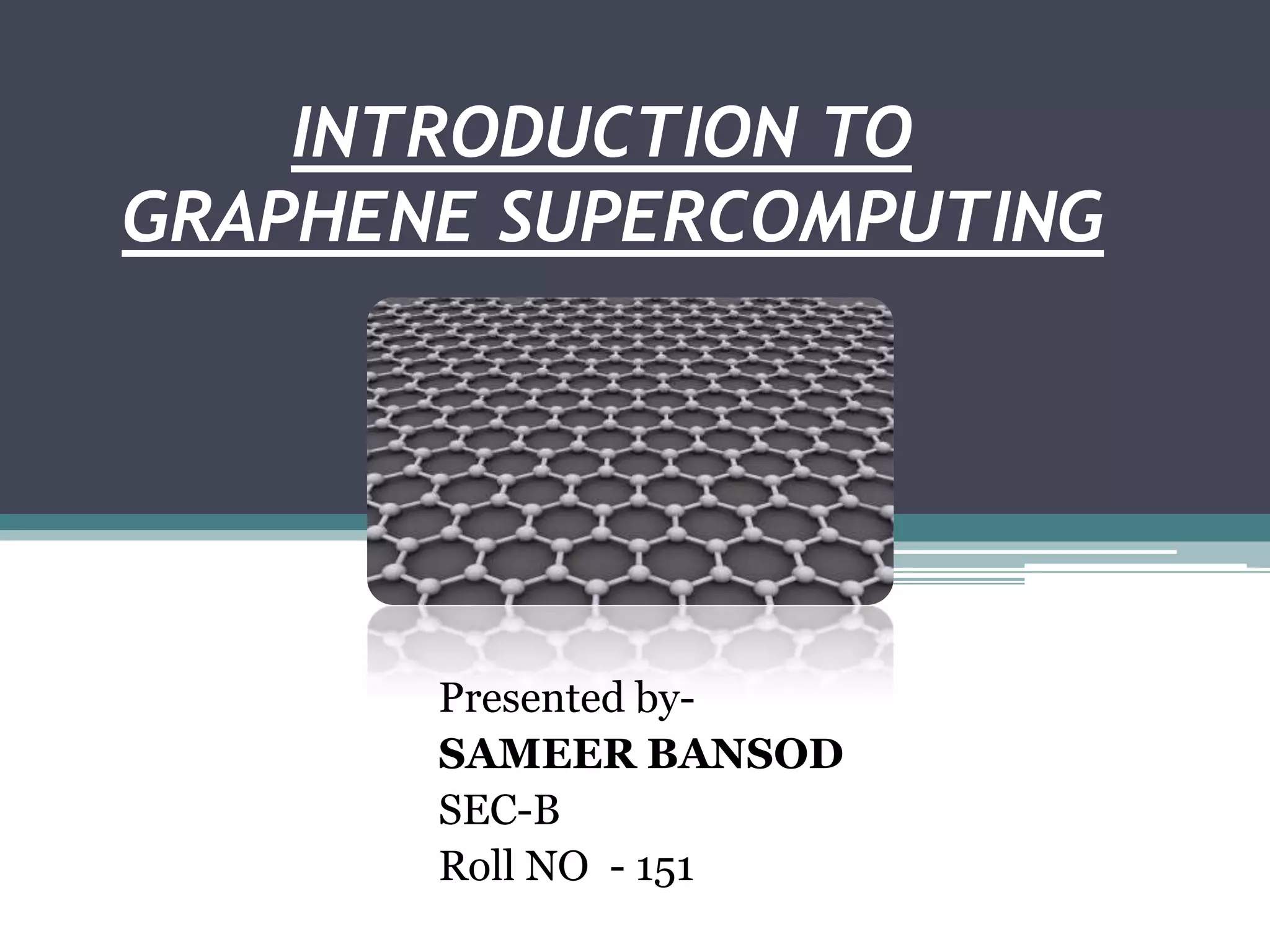
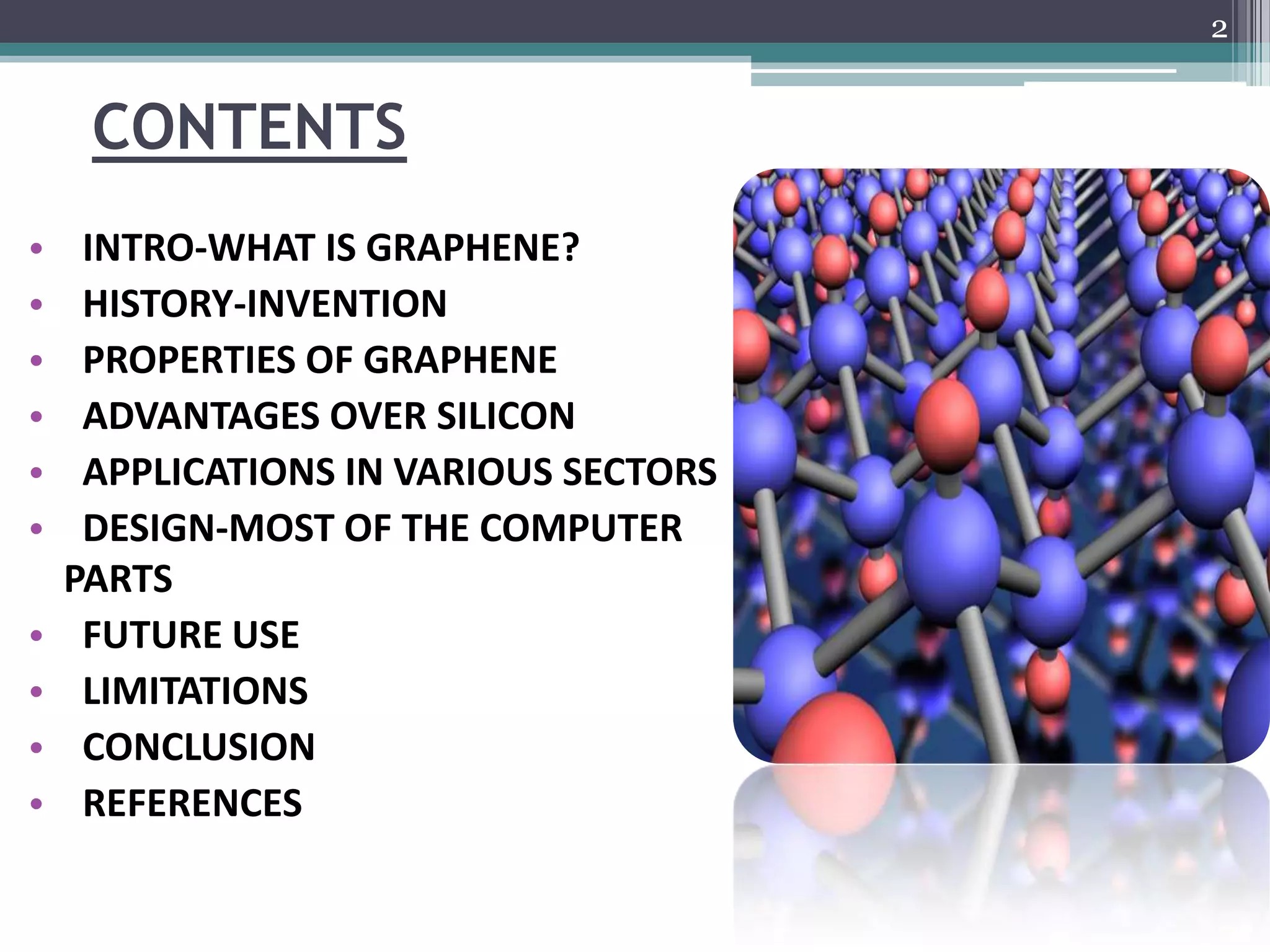
![3
INTRO-WHAT IS GRAPHENE?
• Graphene is a one-atom-
thick planar sheet of carbon
atoms that are densely packed
in a honeycomb crystal lattice.
• Graphite itself consists of
many graphene sheets stacked
together.
• It is an allotrope of carbon
that are densely packed in a
honeycomb crystal lattice.[1]](https://image.slidesharecdn.com/introductiontographene-basedcomputing-121026020855-phpapp01/75/Introduction-to-graphene-based-computing-3-2048.jpg)
![4
CONTINUE-
• The carbon-carbon bond length in graphene is
approximately 0.142 nm.[1]
• Strongest material known to science and
conducts electricity better than any other known
substance.](https://image.slidesharecdn.com/introductiontographene-basedcomputing-121026020855-phpapp01/75/Introduction-to-graphene-based-computing-4-2048.jpg)
![5
• Thin, transparent and flexible
substance..
• Can be used in touch screen,
light panel, solar cells (ITO)
and flexible display [8]](https://image.slidesharecdn.com/introductiontographene-basedcomputing-121026020855-phpapp01/75/Introduction-to-graphene-based-computing-5-2048.jpg)
![6
HISTORY
• The theory behind the substance graphene was
first explored by Scientist Philip Wallace in 1947’s
but didn’t get promising results…[1]
• Since then, in the past 8 years, scientists have
discovered that the substance retains some
amazing properties
• After that-----](https://image.slidesharecdn.com/introductiontographene-basedcomputing-121026020855-phpapp01/75/Introduction-to-graphene-based-computing-6-2048.jpg)
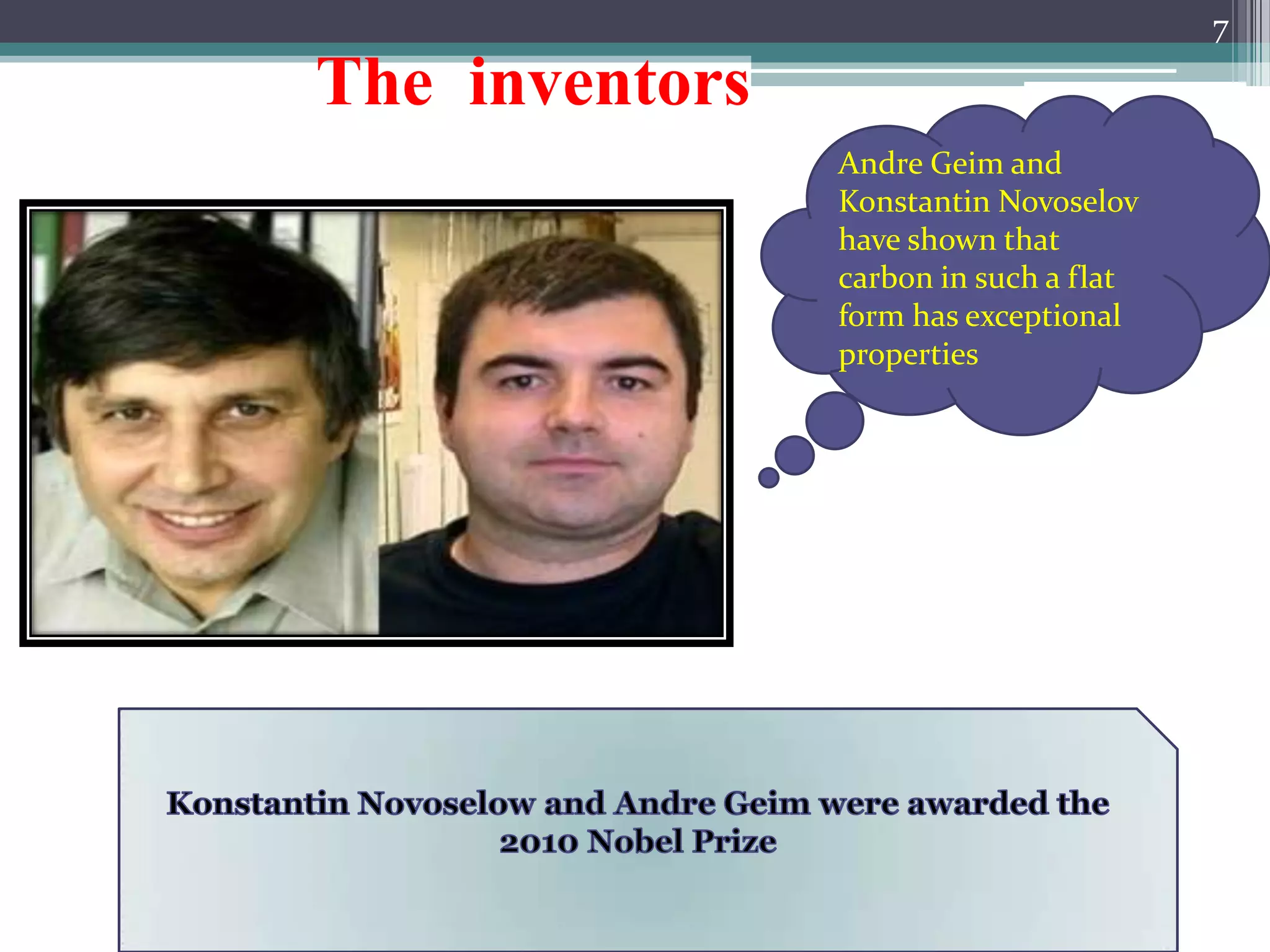
![8
PROPERTIES[1]
• It is 10 times faster than COPPER.
• In Graphene, electrons can flow at very high
speed due to a lack of friction.
• Graphene is stronger and more flexible than
steel and also than diamond.](https://image.slidesharecdn.com/introductiontographene-basedcomputing-121026020855-phpapp01/75/Introduction-to-graphene-based-computing-8-2048.jpg)
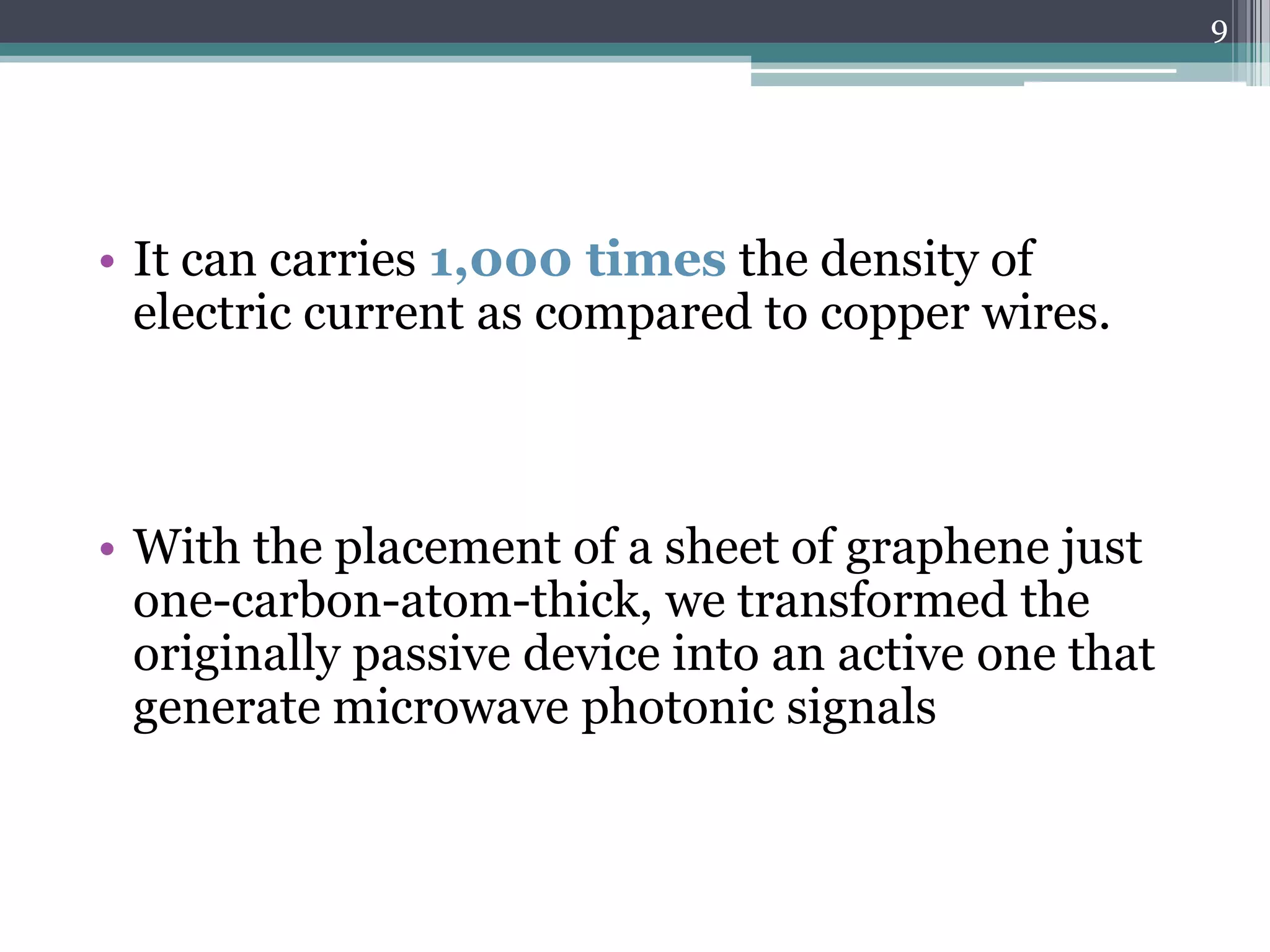
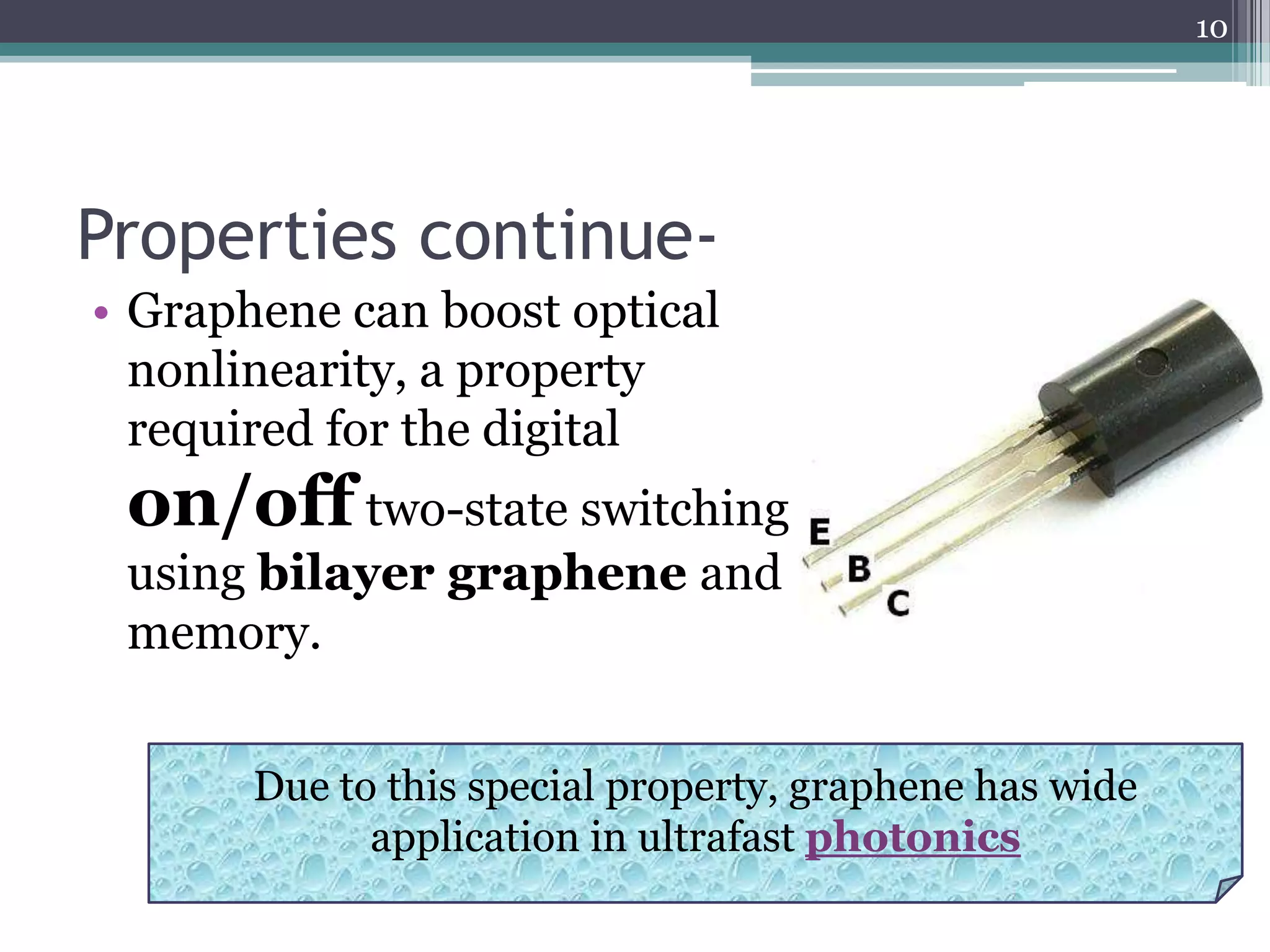
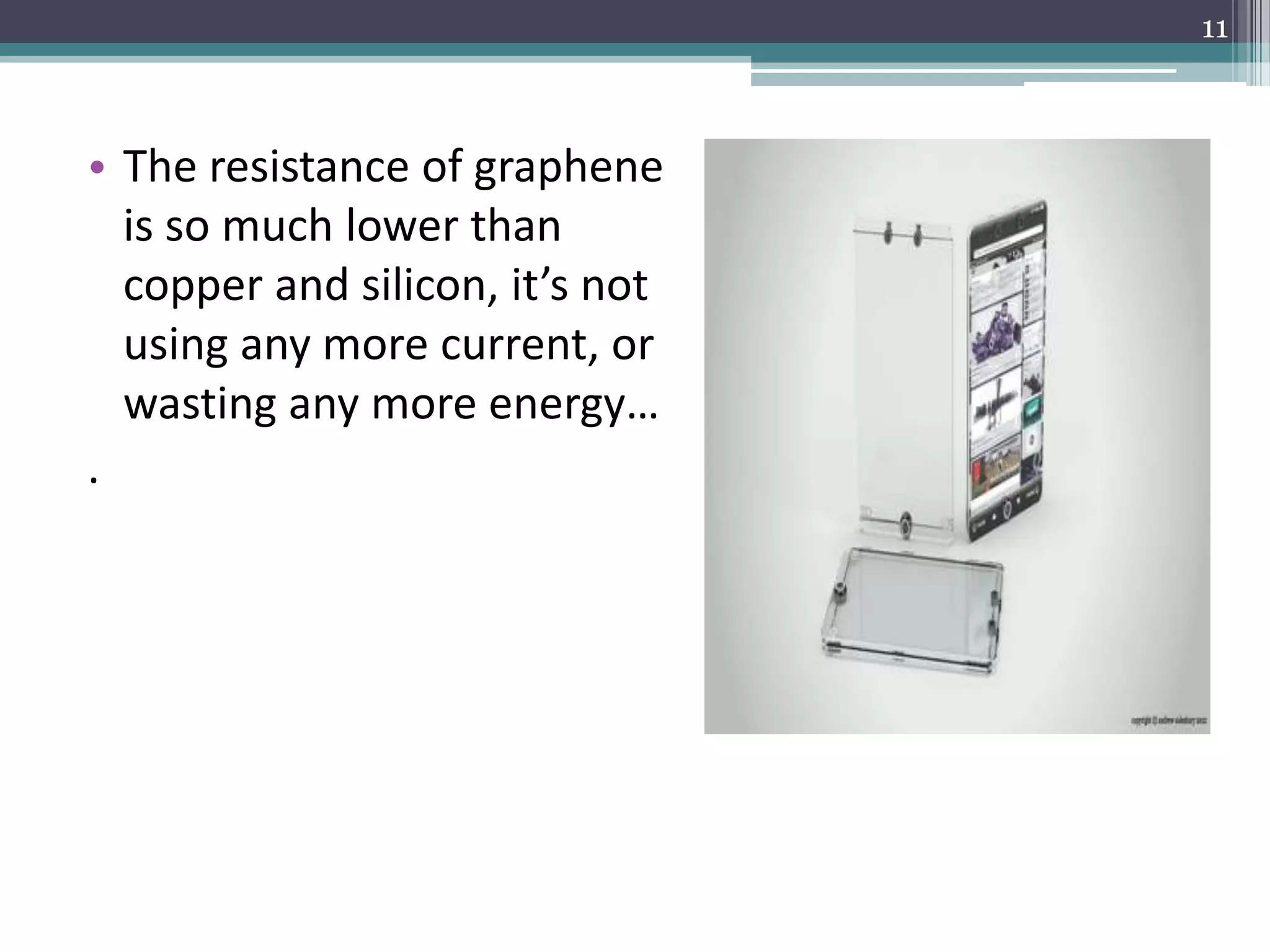
![12
ADVANTAGES OF GRAPHENE OVER
SILICON [3]
• Researcher found the velocity of electrons in the
GRAPHENE was something like 1,000 times
faster than silicon.
• Graphene holds remarkable advantages over
silicon in terms of processing speed, obviating
the need for internal cooling fans as it functions
well at room temperature than SILICON...](https://image.slidesharecdn.com/introductiontographene-basedcomputing-121026020855-phpapp01/75/Introduction-to-graphene-based-computing-12-2048.jpg)
![13
NON- Volatile memories[1]
What is bottleneck with traditional RAM’s ???
• DRAM face severe technological and physical
limitations as device dimensions shrink
• So what is an alternative
Resistive RAM –
- Uses high speed switching mechanism based on
change in resistance
- It has simple structure,high density and fast
switching capabilities.](https://image.slidesharecdn.com/introductiontographene-basedcomputing-121026020855-phpapp01/75/Introduction-to-graphene-based-computing-13-2048.jpg)
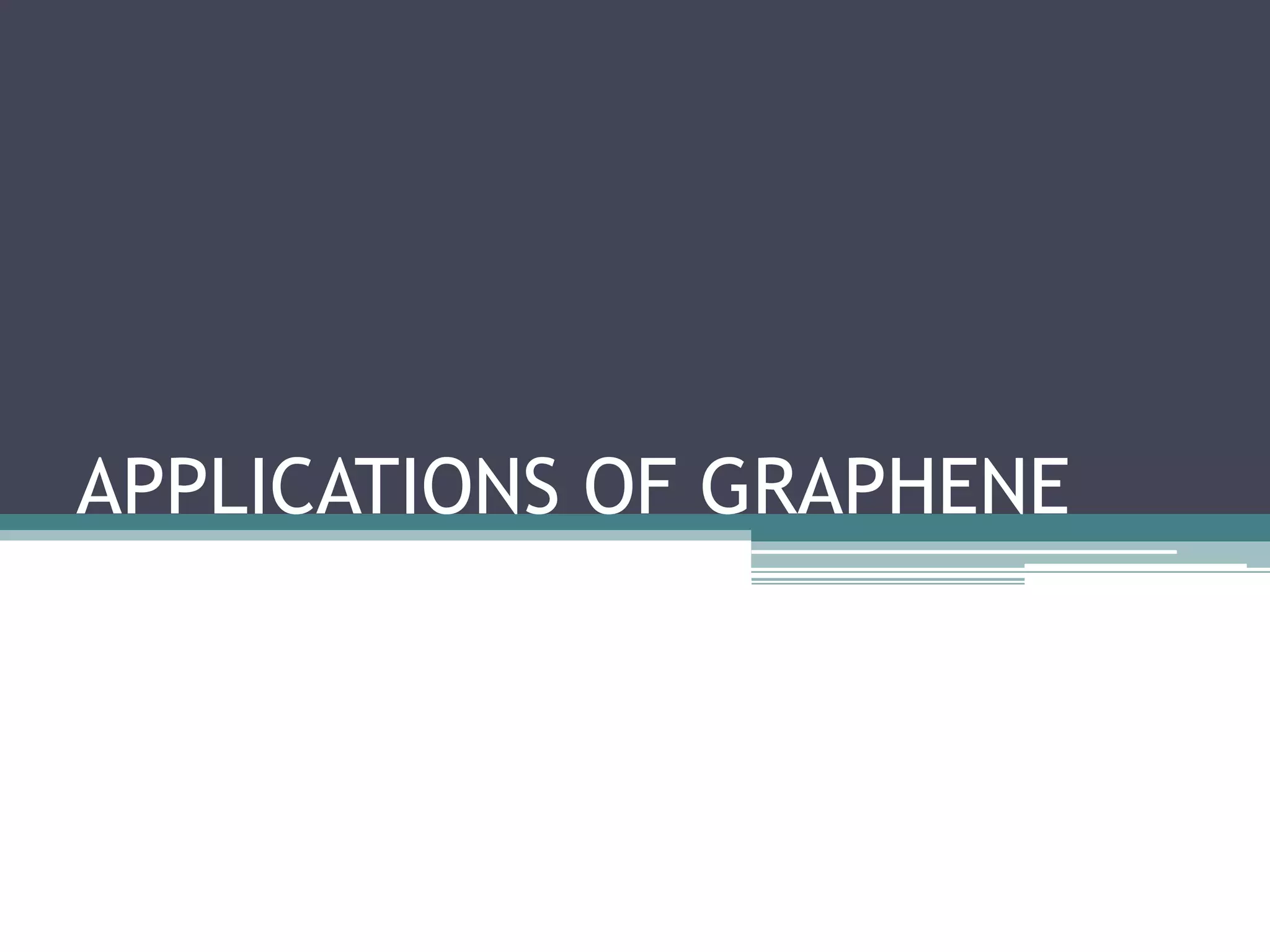
![15
Terahertz devices:[4]
terahertz devices
WHY TERAHERTZ
MODULATING DEVICES ?
THz waves can carry more
information than radio/microwaves
for communications devices
WHAT IS BOTTLENECK ?????
lack of efficient materials and devices that
manipulate these energy waves including traditional
semiconductor devices](https://image.slidesharecdn.com/introductiontographene-basedcomputing-121026020855-phpapp01/75/Introduction-to-graphene-based-computing-15-2048.jpg)
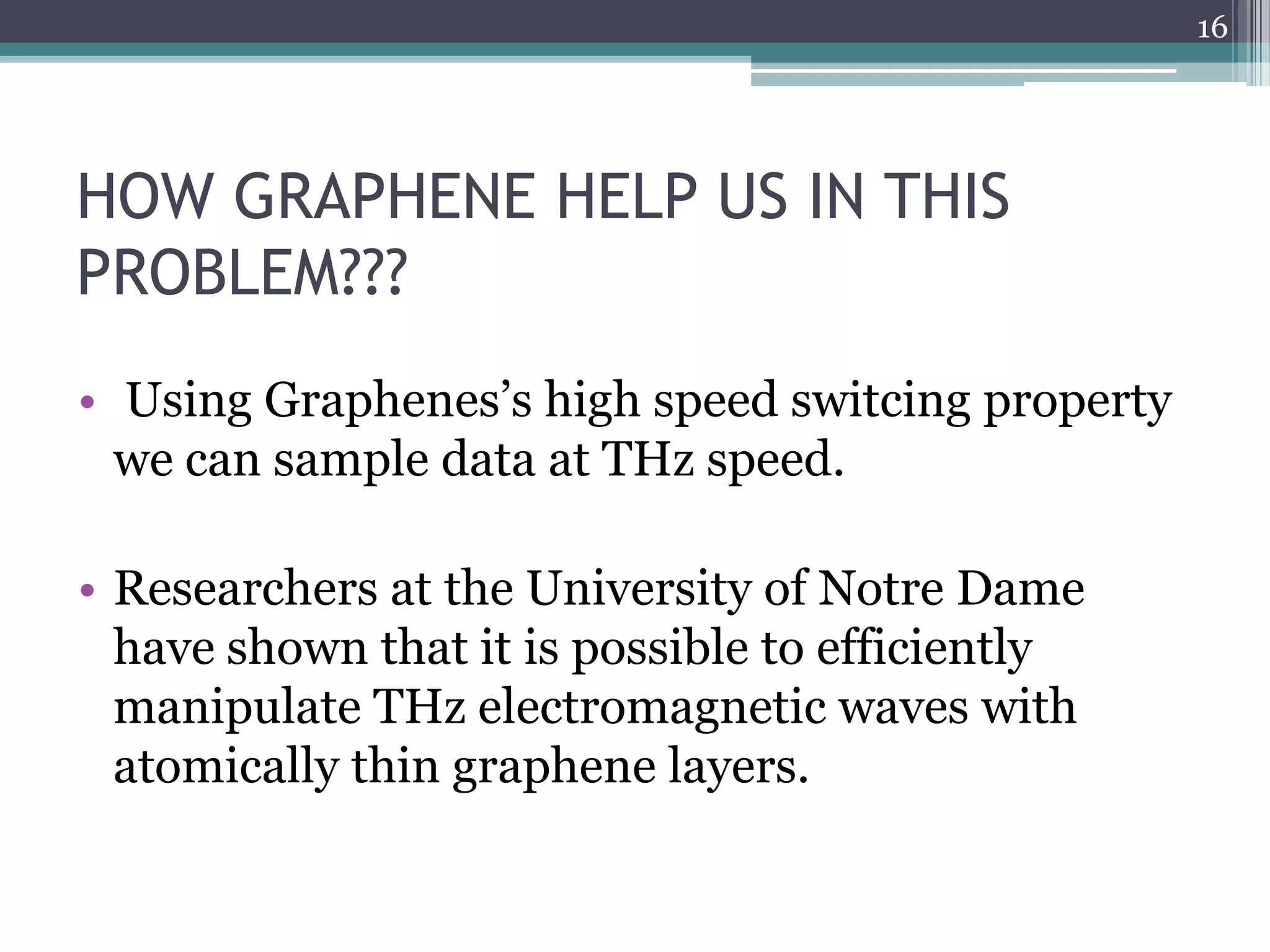
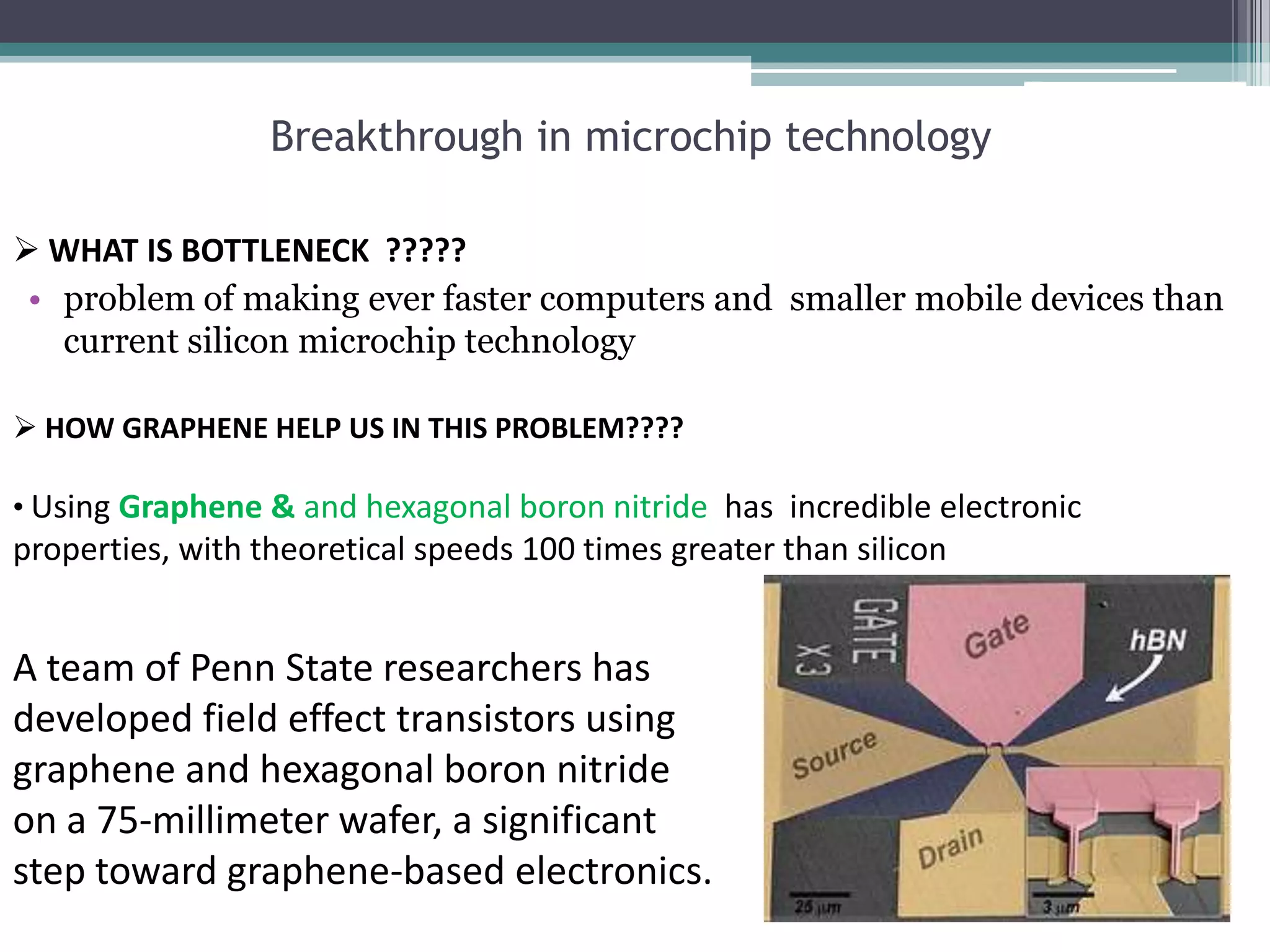
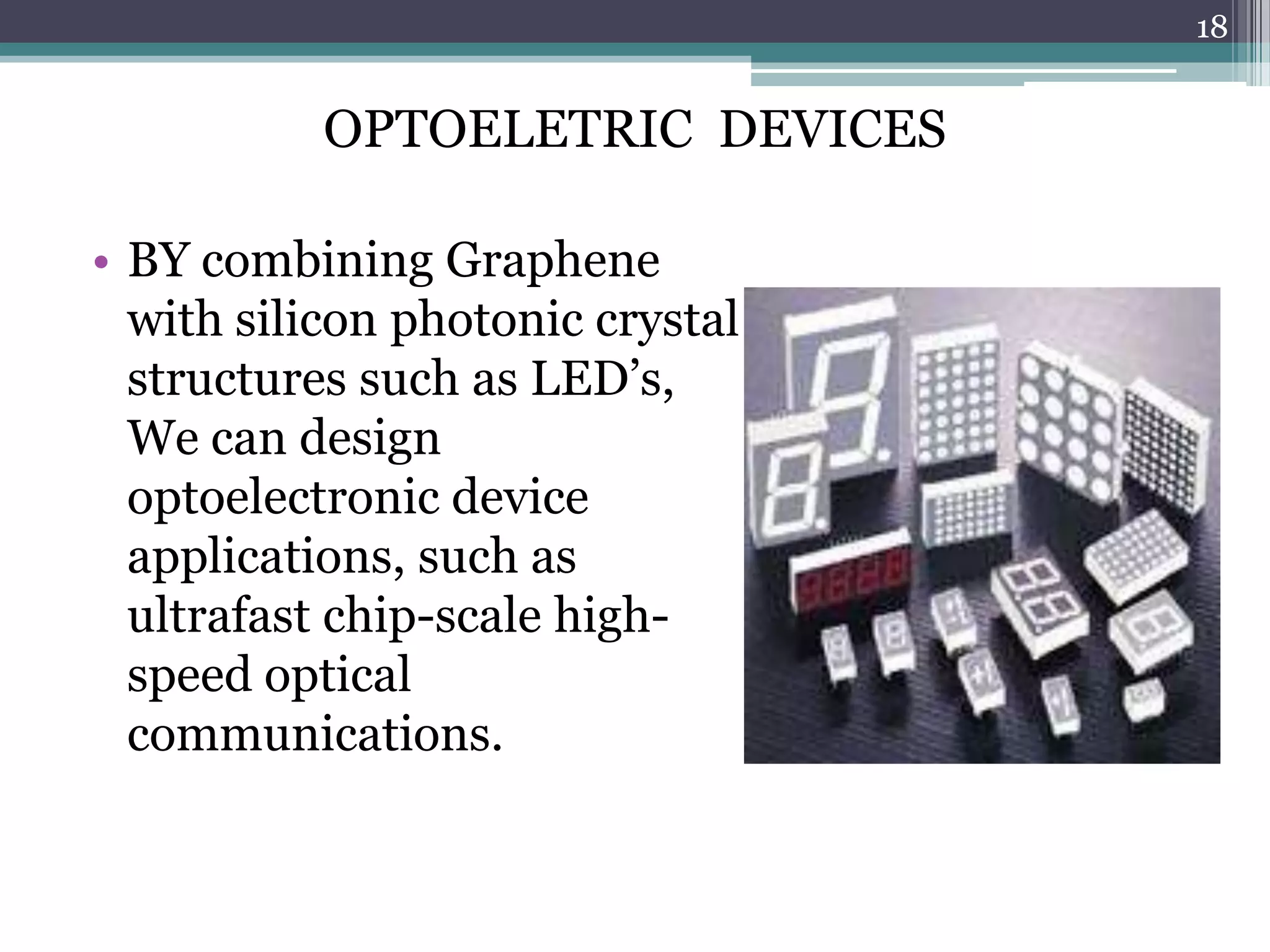
![19
SUPERFAST INTERNET [6]
• By combining graphene with
metallic nanostructures, they
show a 20-fold enhancement in
harvesting light by graphene,
paves advances in high-speed
internet and other
communications.
• Graphene devices can be
incredibly fast and potentially
hundred times faster than
communication rates in the
fastest internet cables..](https://image.slidesharecdn.com/introductiontographene-basedcomputing-121026020855-phpapp01/75/Introduction-to-graphene-based-computing-19-2048.jpg)
![20
Touch screens [8]
• The graphene-based
electrodes could be used
to replace the
increasingly expensive
indium tin oxide (ITO)
in touch-screen
displays. [7]](https://image.slidesharecdn.com/introductiontographene-basedcomputing-121026020855-phpapp01/75/Introduction-to-graphene-based-computing-20-2048.jpg)
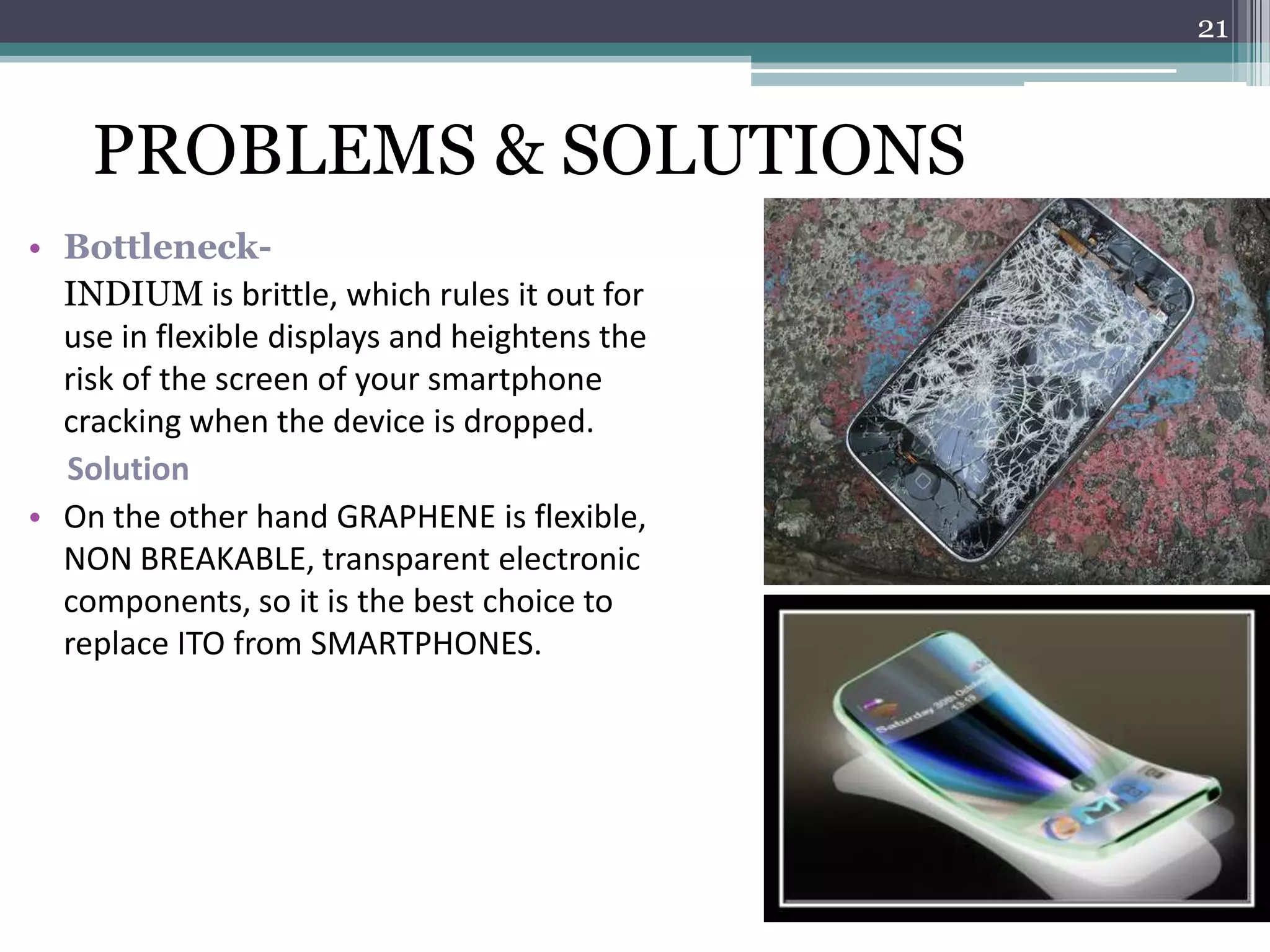
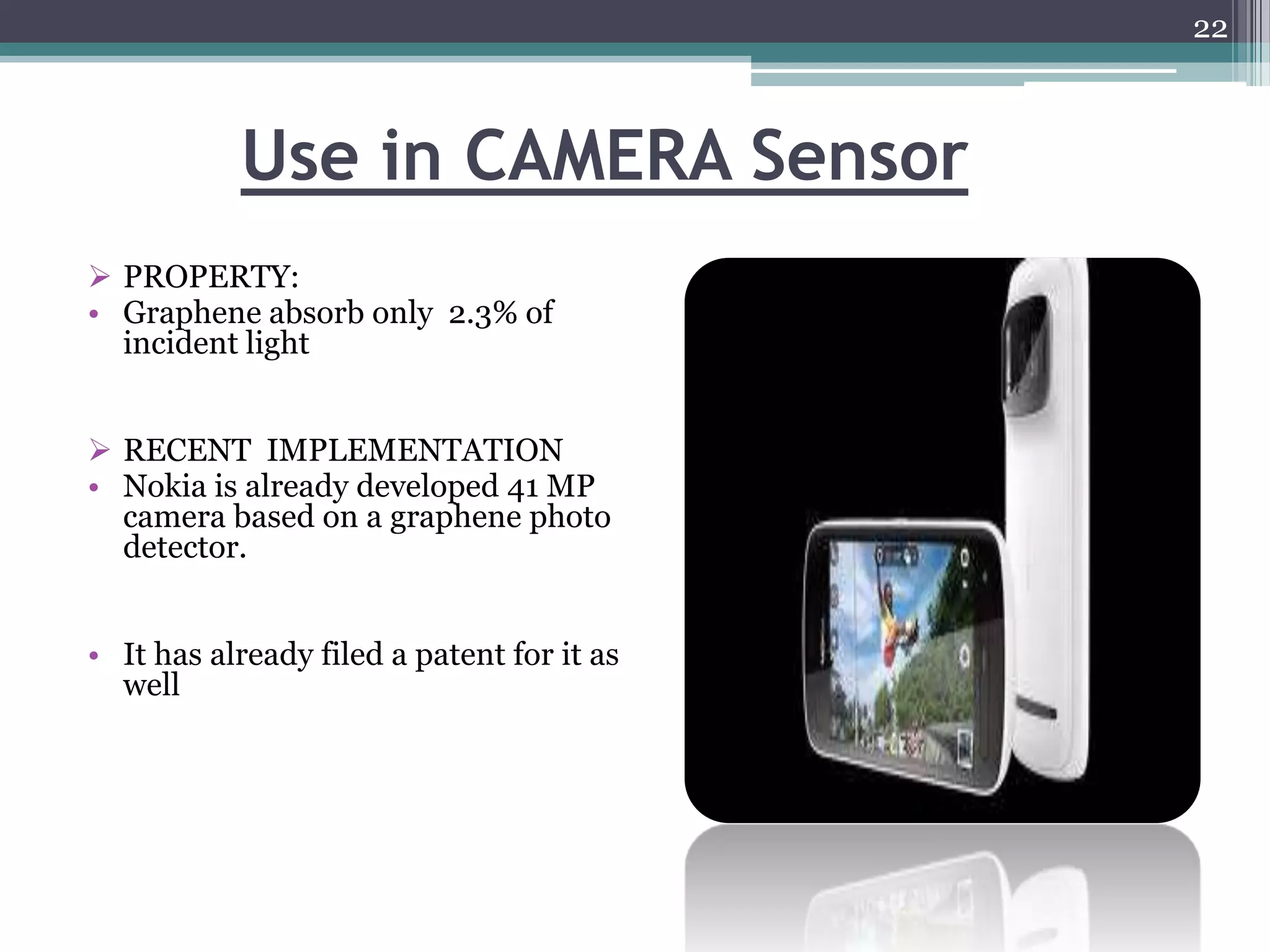
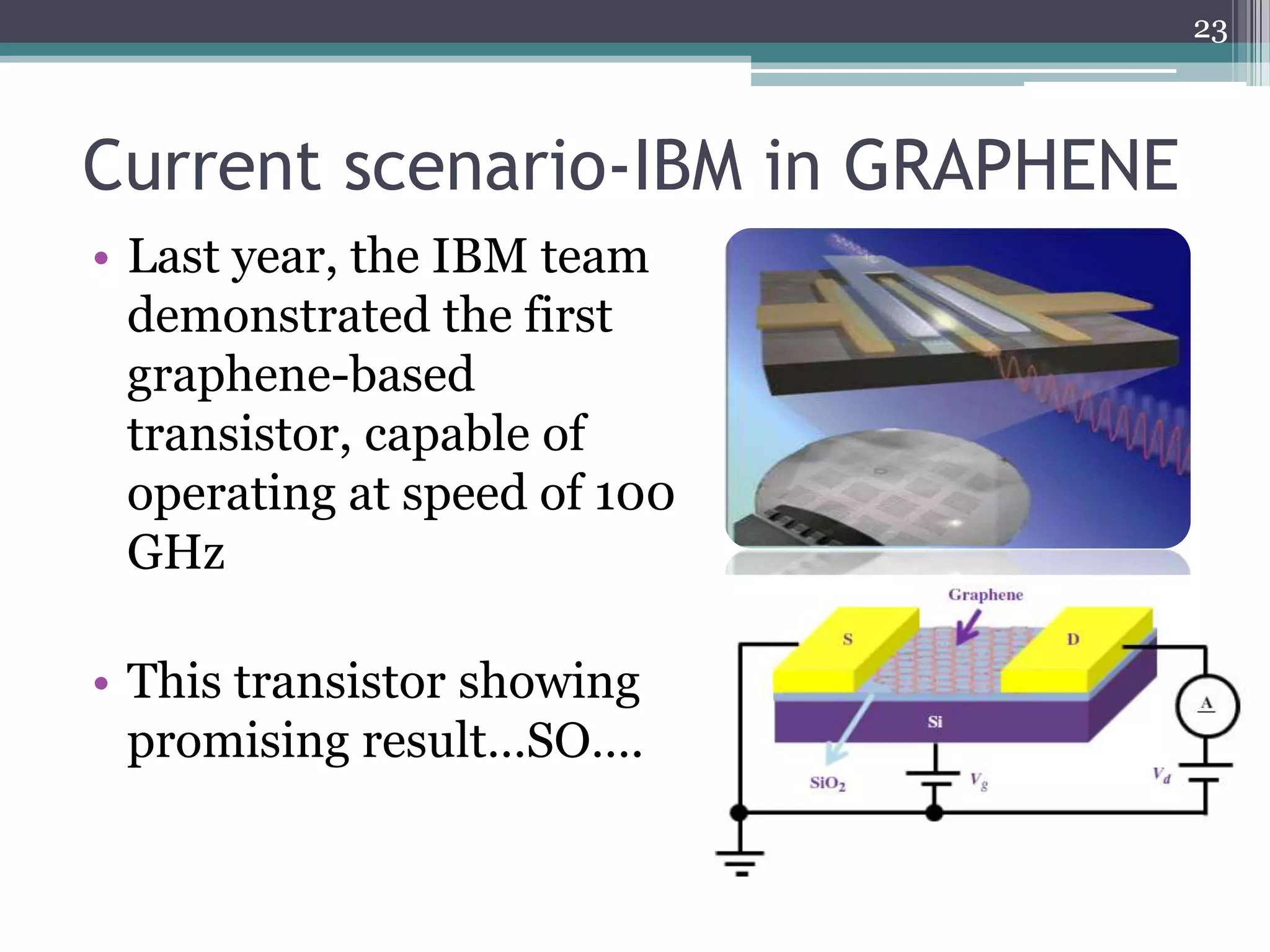
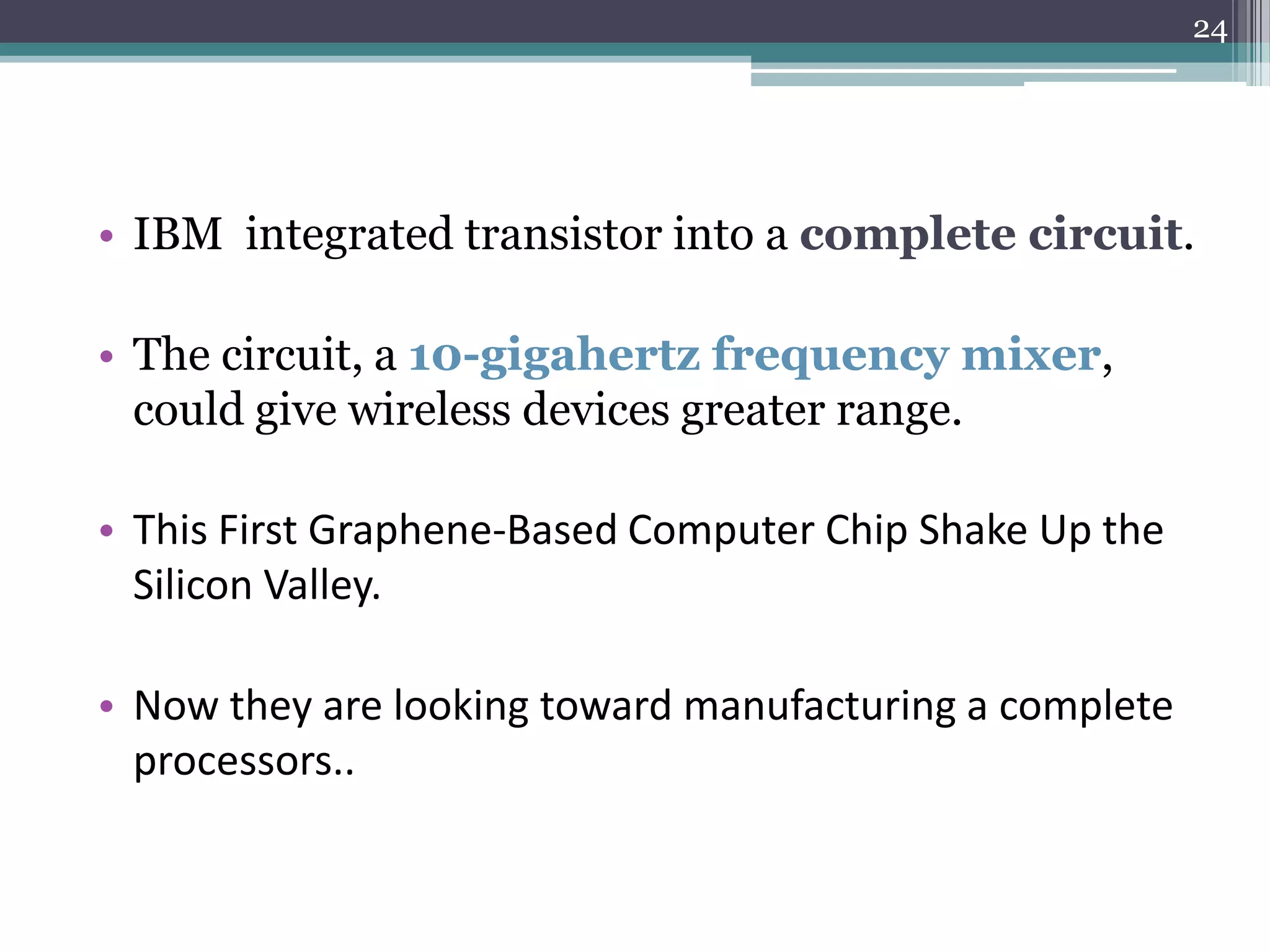
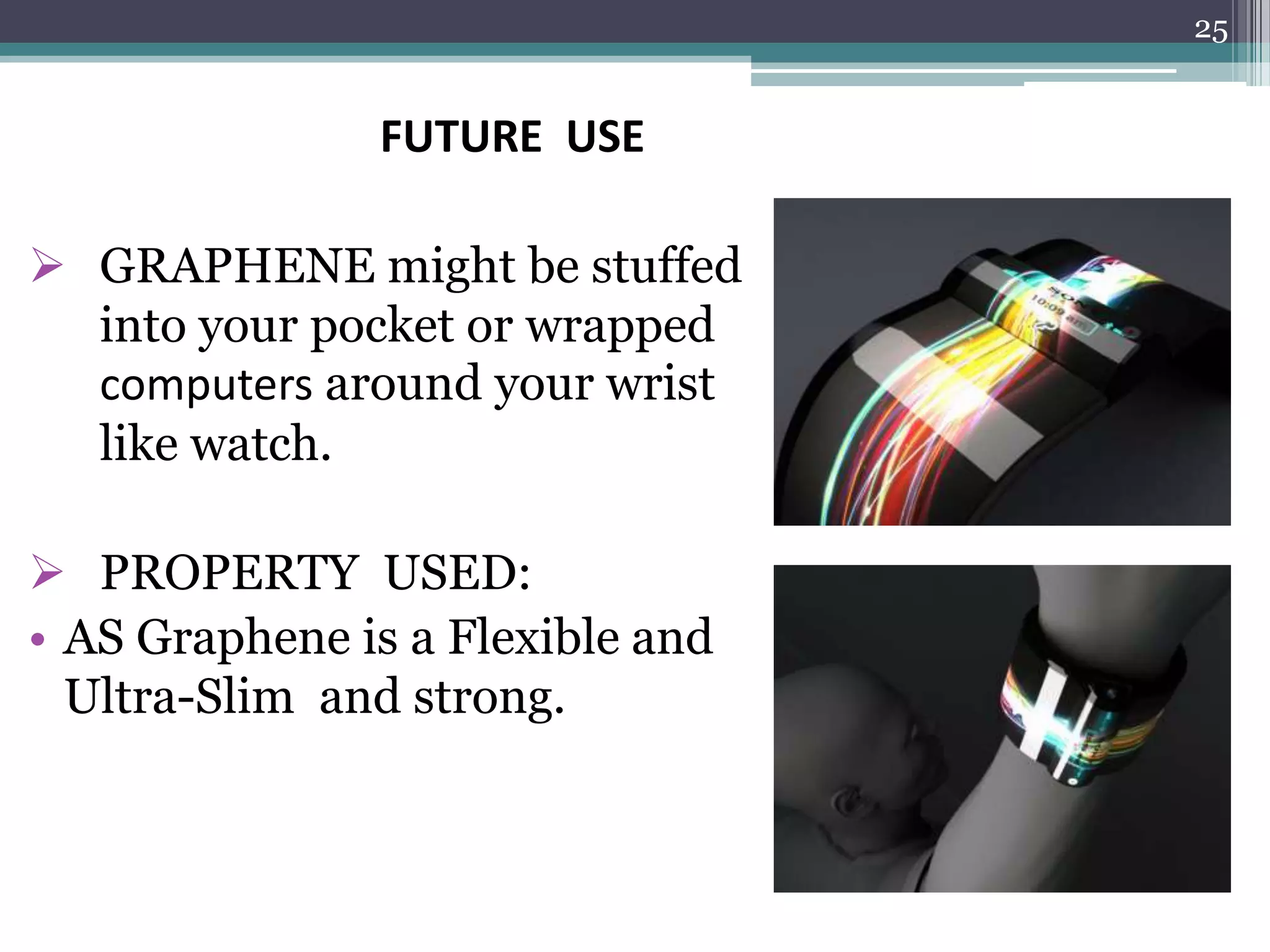
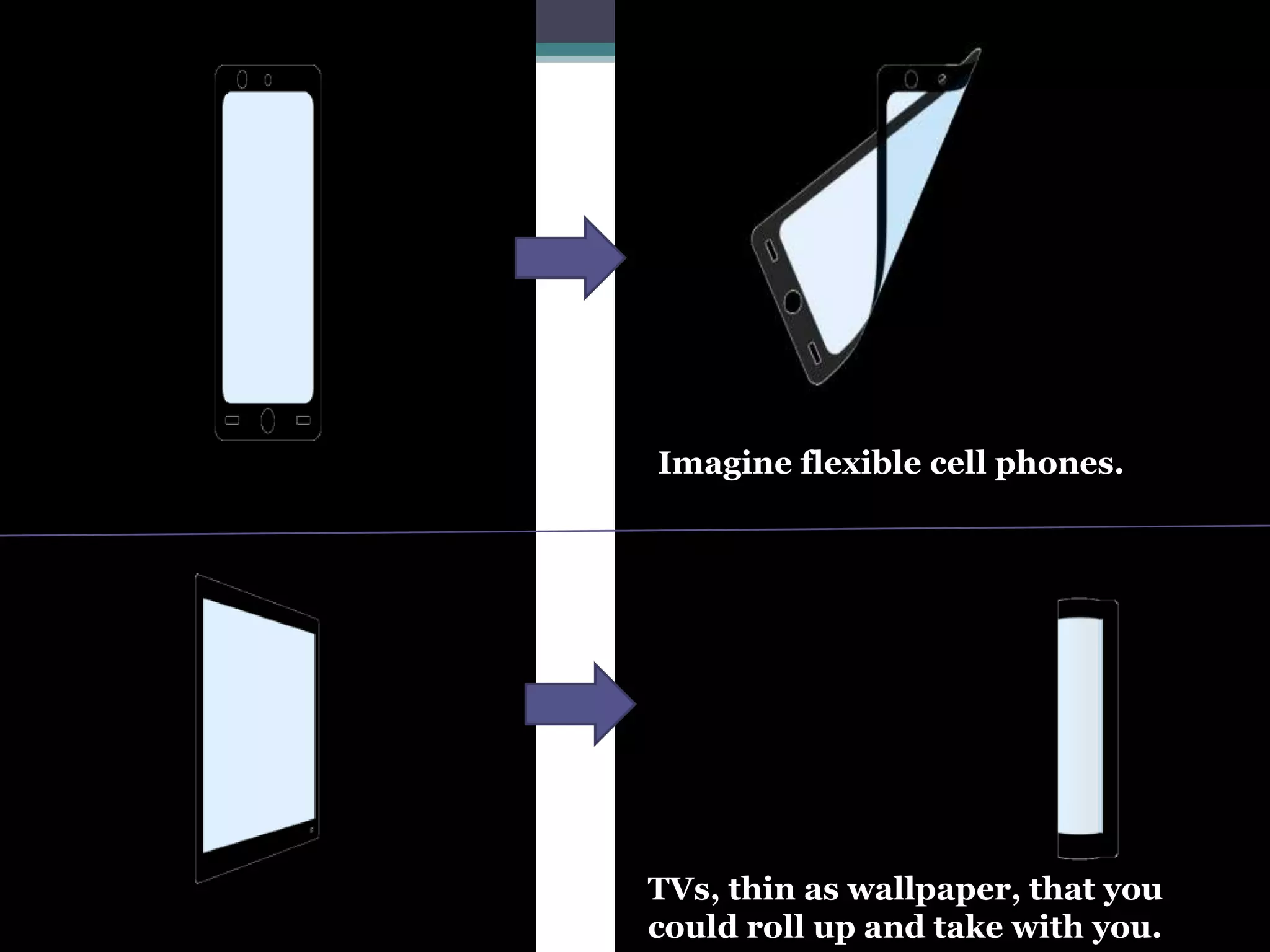
![27
FUTURE USE
• Graphene will use in manufacturing of computer
eletronics because it needs minimal retooling.[1]
• In fact, IBM has already created working
on 30GHz test devices using graphene
transistors by 2020.](https://image.slidesharecdn.com/introductiontographene-basedcomputing-121026020855-phpapp01/75/Introduction-to-graphene-based-computing-27-2048.jpg)
![28
• The first products are expected to enter the
market by 2014, according to estimates by
Samsung.[6]
• Many leading electronics companies consider
graphene for the next generation of devices. This
work certainly boosts graphene's chances even
further.](https://image.slidesharecdn.com/introductiontographene-basedcomputing-121026020855-phpapp01/75/Introduction-to-graphene-based-computing-28-2048.jpg)
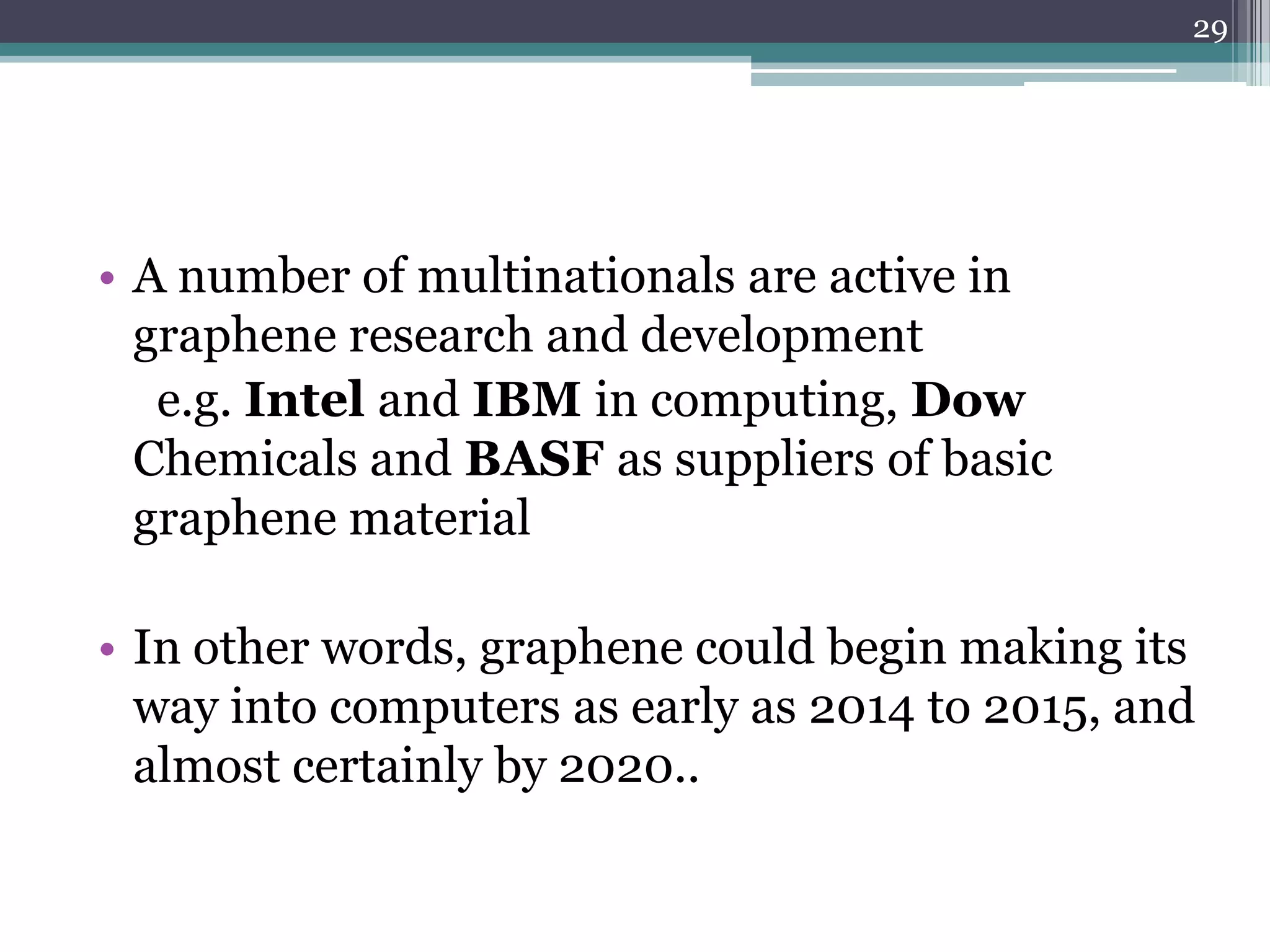
![30
• We might be able to see graphene based photo
sensors in Nokia’s smart phones.
• Graphene for use in graphene-saturated battery and
super-charging capacitor applications ..[8]](https://image.slidesharecdn.com/introductiontographene-basedcomputing-121026020855-phpapp01/75/Introduction-to-graphene-based-computing-30-2048.jpg)
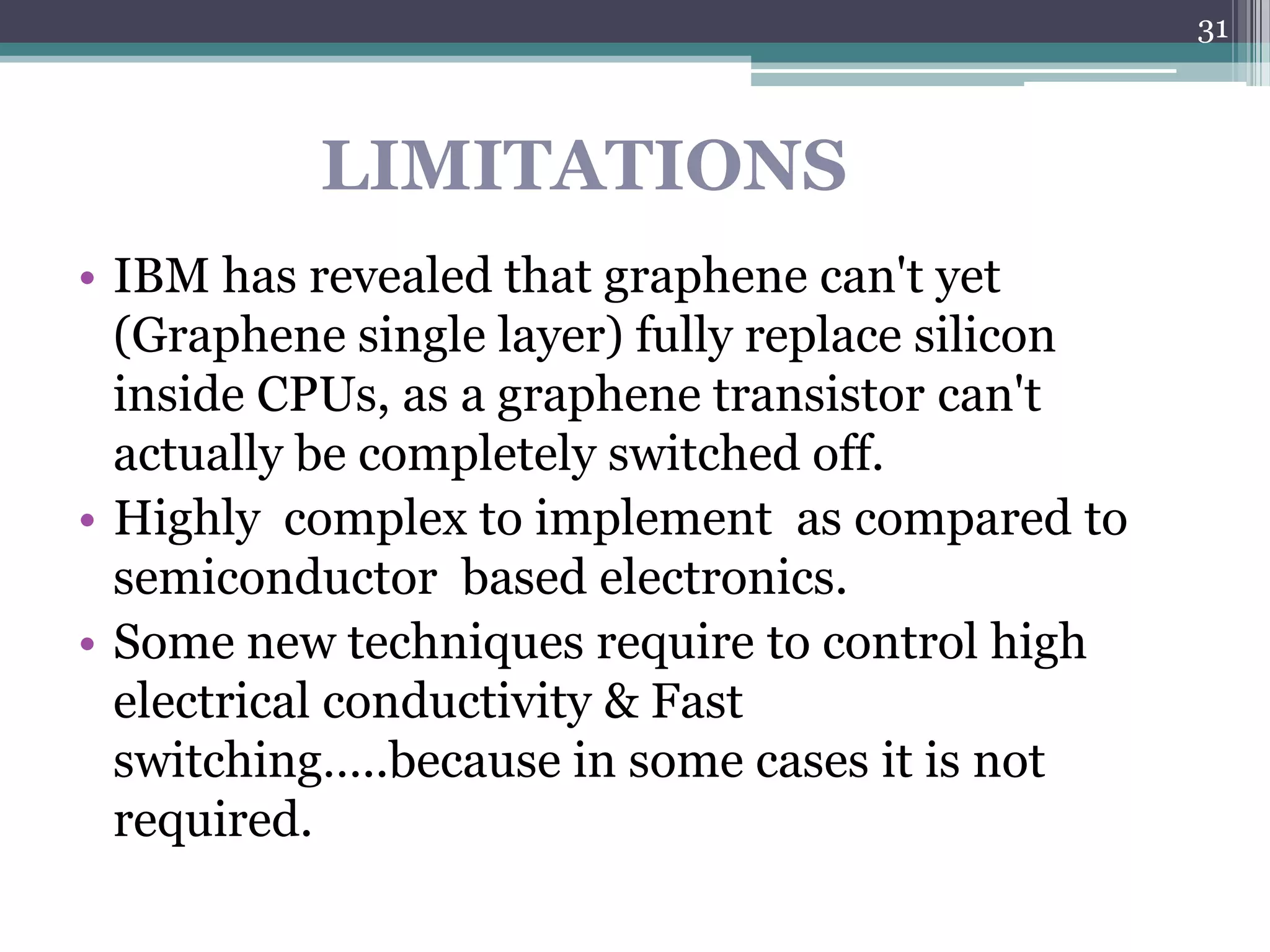
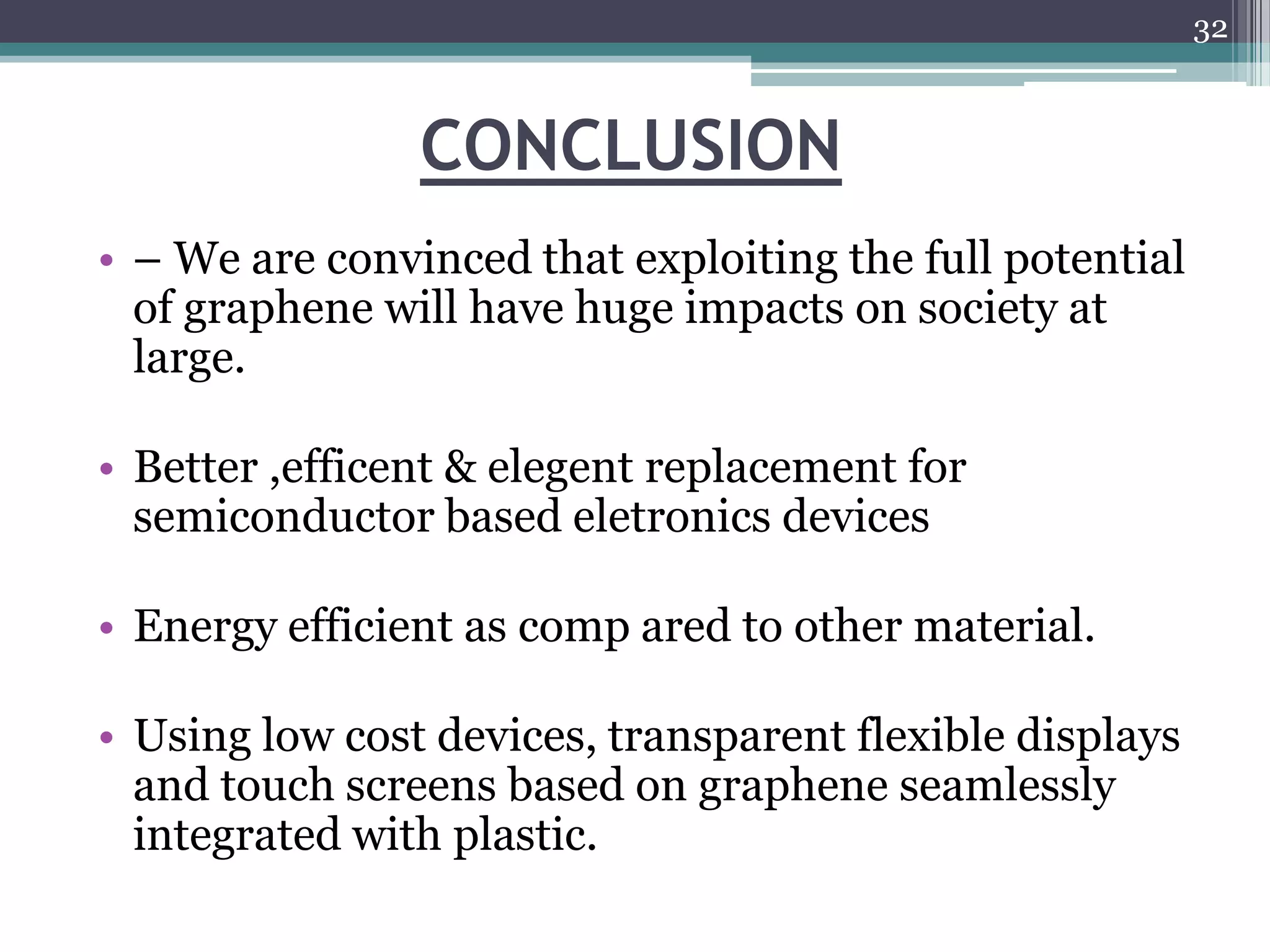
![33
• In future New Material, Graphene may replace
Silicon in Technology Industry as Experts
say....[8]](https://image.slidesharecdn.com/introductiontographene-basedcomputing-121026020855-phpapp01/75/Introduction-to-graphene-based-computing-33-2048.jpg)
![34
34
Why should we get excited about
graphene?[5]
• It’s extremely thin, it has extremely good
connectivity.
• What we’ve found that it is bigger substance
than what we had expected.
• It is called as a ‘MIRACLE’ material,which has
an applications in numerous fields..](https://image.slidesharecdn.com/introductiontographene-basedcomputing-121026020855-phpapp01/75/Introduction-to-graphene-based-computing-34-2048.jpg)
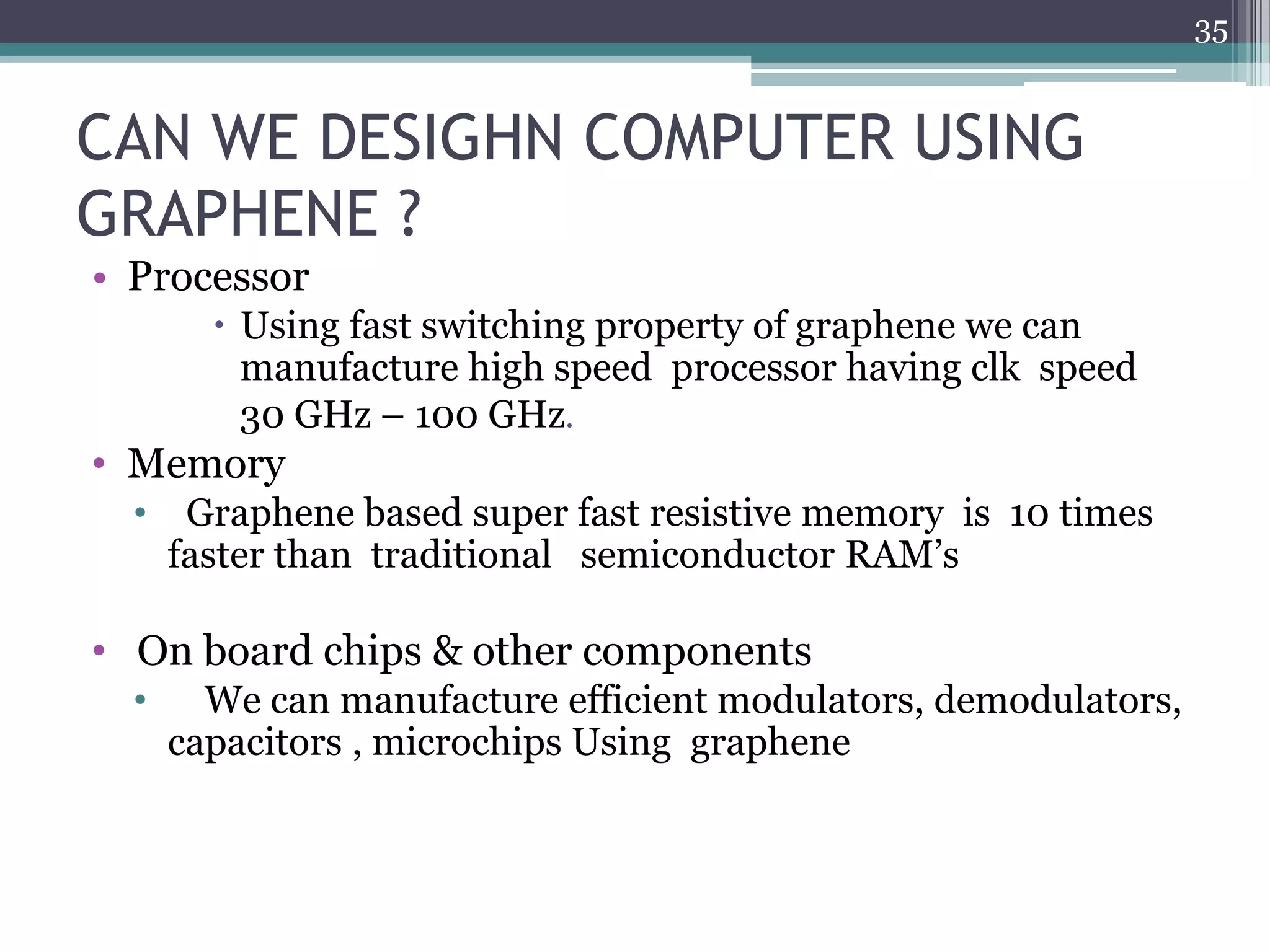
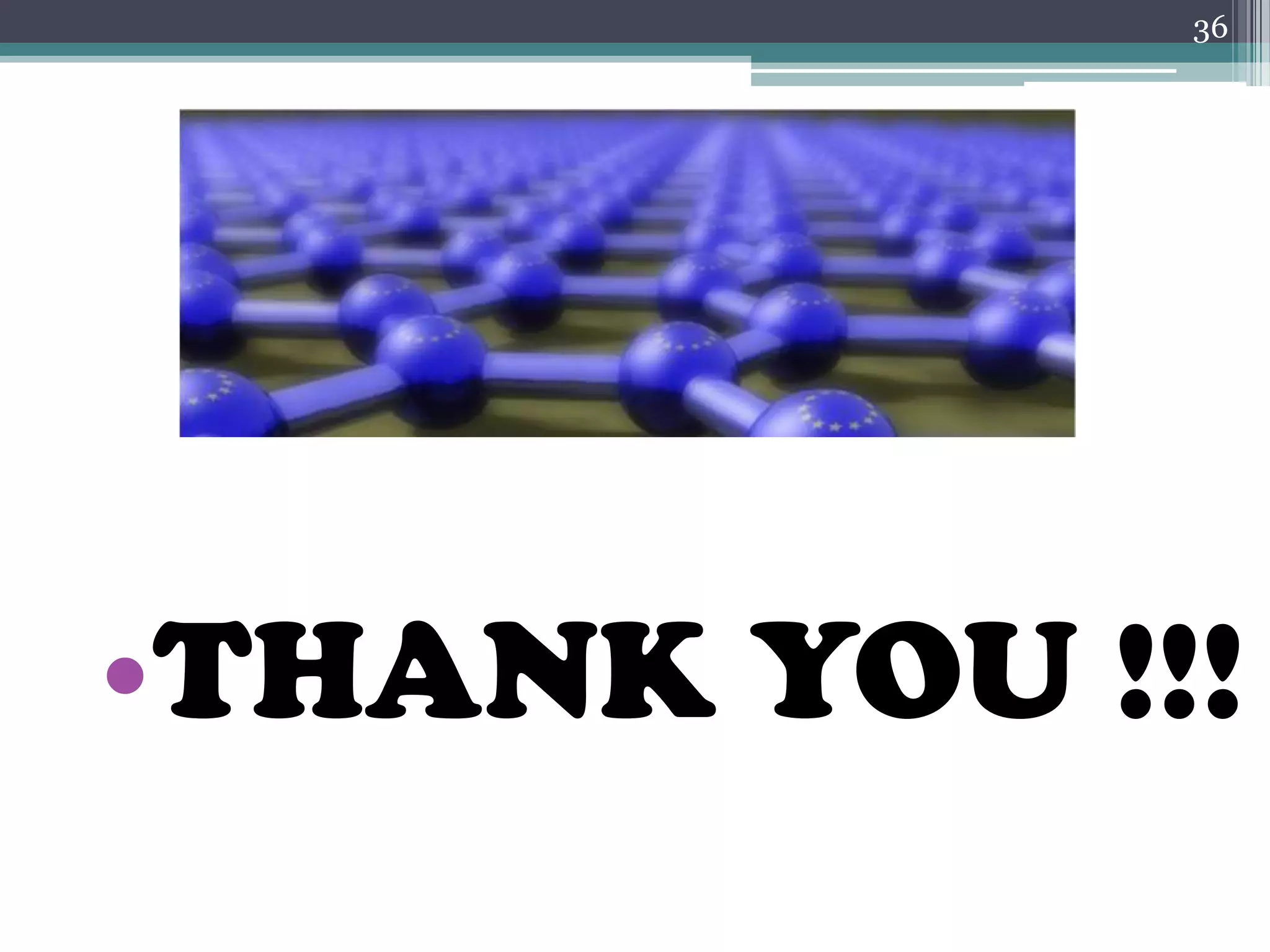
 THE RISE OF GRAPHENE
.[Online].Available:
http://arxiv.org/ftp/condmat/papers/0702/0702595.pdf
A.K. Geim and K.S. Novoselov
Manchester Centre for Mesoscience and Nanotechnology,
University of Manchester, Oxford Road M13 9PL, United Kingdom
[2] (Google) Valkyrie Ice,”GRAPHENE IS NEXT”
.[Online].Available: http://hplusmagazine.com/2010/05/03/graphene-
next/operating-system.html, MaY 3, 2010.
[3] (Google) First Graphene-Based Computer Chip May Shake Up
Silicon Valley
.[Online].Available:http://www.foxnews.com/tech/2011/06/13/first-graphene-
based-computer-chip-may-shake-up-silicon-valley/ JUNE 13,2011](https://image.slidesharecdn.com/introductiontographene-basedcomputing-121026020855-phpapp01/75/Introduction-to-graphene-based-computing-37-2048.jpg)
![38
[4] (Google),”GRAPHENE Wonder material ”
.[Online].Available: www.Phys.org/graphene
[5]GRAPHENE
Link site:http://www.focusgraphite.com/technology/graphene
[6]GRAPHENE-Flagship
Link site: http://www.graphene-flagship.eu/GF/reports.php
[7] Professor Konstantin Novoselov , Interview,Graphene
[Video].Available: https://www.youtube.com/watch?v=e8TrTWdzon4
[8] Dream touch-screens from graphene at Rice University
[Video].Available:https://www.youtube.com/watch?v=e8TrTWdzon4](https://image.slidesharecdn.com/introductiontographene-basedcomputing-121026020855-phpapp01/75/Introduction-to-graphene-based-computing-38-2048.jpg)